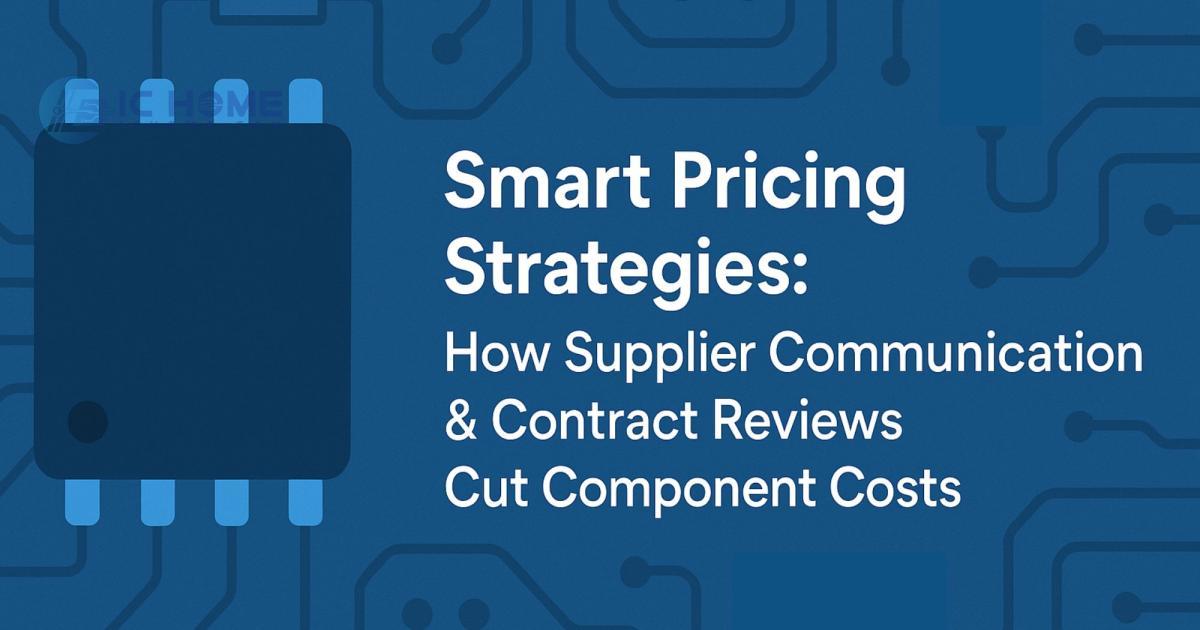Smart Pricing Strategies: How Supplier Communication & Contract Reviews Cut Component Costs
In the ever-changing landscape of the electronics industry, managing procurement costs effectively is more than a matter of negotiation—it's a matter of strategy. Market fluctuations, raw material shortages, geopolitical instability, and supply chain disruptions can all lead to price volatility for electronic components. For procurement professionals, especially those dealing with high-mix, low-volume components or long lifecycle projects, pricing predictability is critical to cost control, profitability, and product competitiveness.
One of the most effective ways to navigate these challenges is through regular communication with suppliers and the strategic review of pricing clauses in contracts.

The Importance of Ongoing Supplier Communication
Why is regular dialogue with suppliers so important? The electronic components market doesn’t operate in a vacuum. Suppliers constantly respond to changes in:
-
Raw material costs (copper, silicon, rare earths)
-
Manufacturing capacity constraints
-
Logistics and freight costs
-
Environmental regulations (e.g., RoHS, REACH updates)
-
Currency exchange rate shifts
By staying in close contact with suppliers, procurement teams gain early insights into upcoming changes that may affect availability, pricing, or lead times. This proactive intelligence allows buyers to:
-
Prepare for cost increases before they hit
-
Plan last-time buys if a component is becoming obsolete
-
Evaluate cross-references or alternative components solution early in the cycle
-
Avoid production delays due to unexpected price negotiations or shortages
Moreover, frequent communication signals that your organization is a serious, collaborative partner—something suppliers value, especially when demand is high and supply is tight.
Structuring Pricing Clauses: Not Just Legal Language, But a Strategic Lever
Contracts are more than legal protection—they are strategic documents that can shape long-term supplier behavior and cost control. Unfortunately, many procurement teams overlook the power of pricing clauses. Here’s what you should be paying close attention to:
1. Pricing Validity Period
This defines how long the agreed-upon unit prices remain fixed. Depending on market volatility, these can range from 30 days to 12 months. High-volume, stable components may allow for longer fixed terms.
2. Review and Adjustment Cycles
Specify the frequency of price reviews—quarterly, semi-annual, or annually. Make sure both parties agree to review windows so renegotiation is timely and data-supported.
3. Escalation Triggers and Thresholds
What conditions warrant a price adjustment? Consider codifying cost drivers like material price indexes, fuel rates, or inflation thresholds. This creates a data-driven basis for price changes and removes ambiguity.
4. Price Cap and Floor Limits
To prevent excessive pricing swings, consider defining maximum and minimum adjustment ranges within a period. This protects both your margins and the supplier’s viability.
5. Exchange Rate Clauses (if applicable)
For international transactions, fluctuations in USD, EUR, or RMB can affect component pricing. Including an FX clause can help stabilize total cost forecasts.
The Cost of Ignoring Pricing Structure
When contracts lack clarity on pricing updates, procurement teams face:
-
Budget overruns
-
Production delays caused by internal approval bottlenecks
-
Damaged supplier relationships from price disagreements
-
Missed opportunities for bulk discounts or strategic buys
In contrast, having transparent pricing terms transforms these potential risks into predictable workflows—and that’s invaluable in a market known for its unpredictability.
Practical Steps for Procurement Teams
If you want to turn pricing reviews and supplier engagement into a competitive advantage, consider these best practices:
- Build a Supplier Contact Calendar
Schedule regular touchpoints (monthly or quarterly) with key suppliers. Use these meetings to discuss not just current pricing, but forecasts, upcoming product changes, or alternative options. - Use Market Intelligence Tools
Track component pricing trends using global indexes or lifecycle management platforms. This gives you real-time data to support contract negotiations or resist unjustified increases. - Classify Suppliers and Parts Strategically
For critical or sole-sourced components, push for longer validity periods and stronger price protection. For more volatile or C-class parts, build flexibility into pricing and approval flows. - Partner with Distributors Who Offer More Than Just Parts
Work with authorized distributors that provide real-time availability data, price trend reports, lifecycle alerts, and proactive PCN communication. These insights are essential when prices shift quickly. - Document All Agreements Clearly
Avoid informal or verbal pricing agreements. Ensure all terms—including adjustment mechanisms—are documented in supplier contracts or purchase agreements.
Future-Proofing Your Procurement Strategy
With global demand for electronic components only expected to rise—especially in industries like automotive, industrial automation, and IoT—procurement organizations must evolve from transactional buyers to strategic planners.
Price changes are inevitable, but their impact doesn’t have to be disruptive. By aligning your team around regular supplier engagement and well-defined contract terms, you create a sourcing model that is resilient, flexible, and cost-effective.
Conclusion
In a volatile industry where change is constant, the ability to anticipate, negotiate, and adapt to pricing shifts is what separates reactive procurement teams from strategic ones. By reviewing contract pricing clauses regularly and fostering open supplier communication, electronic component buyers can reduce cost uncertainty, prevent supply interruptions, and gain a stronger position in a highly competitive market.




